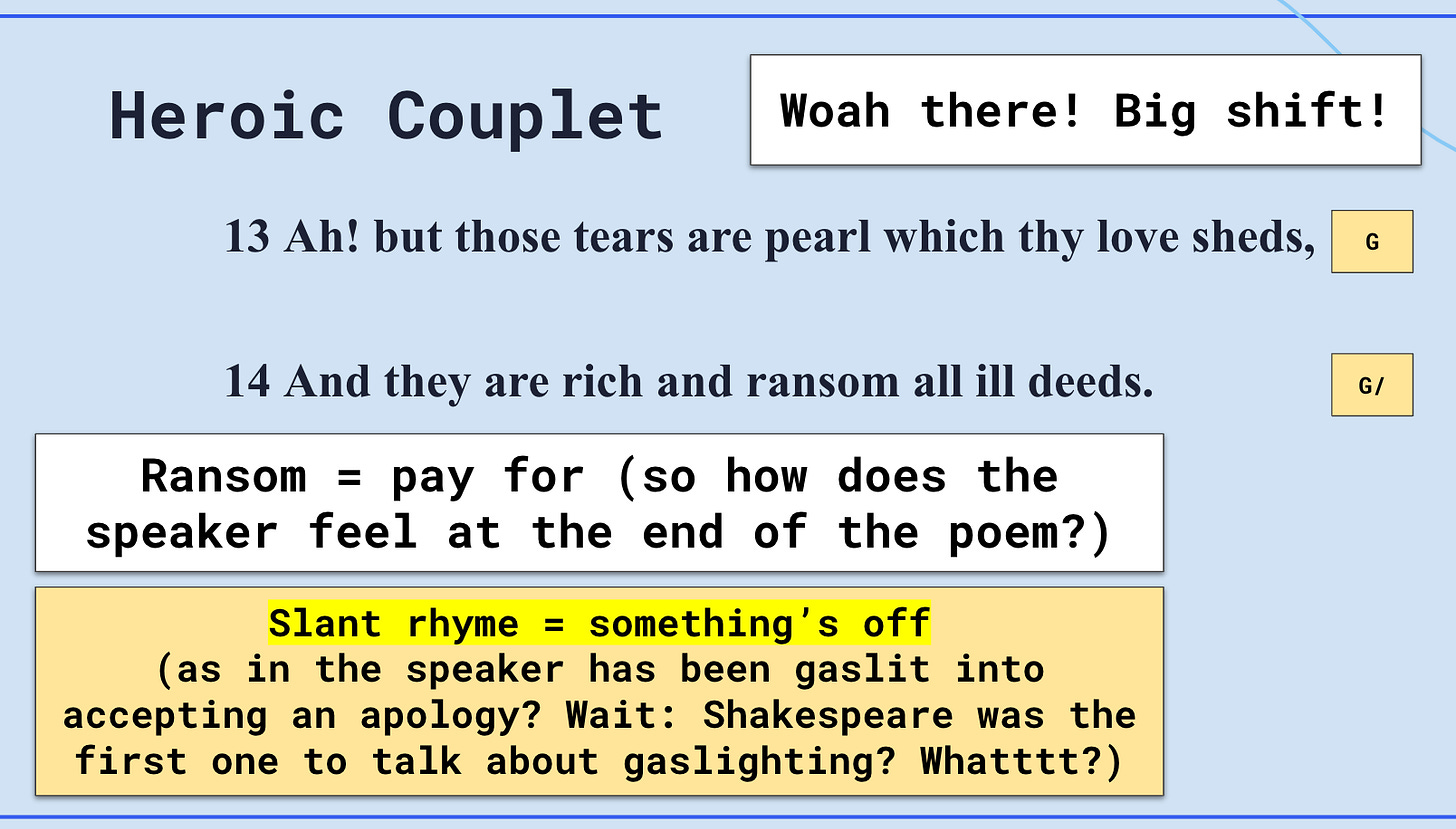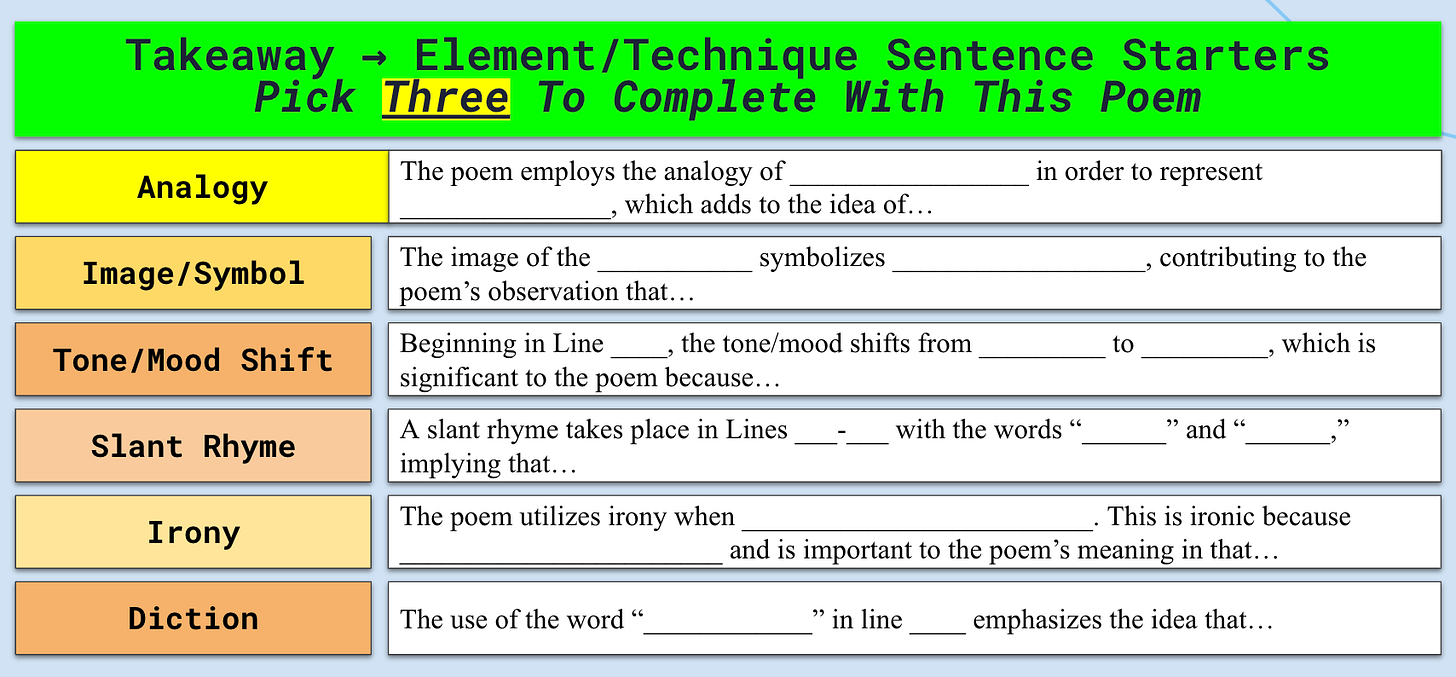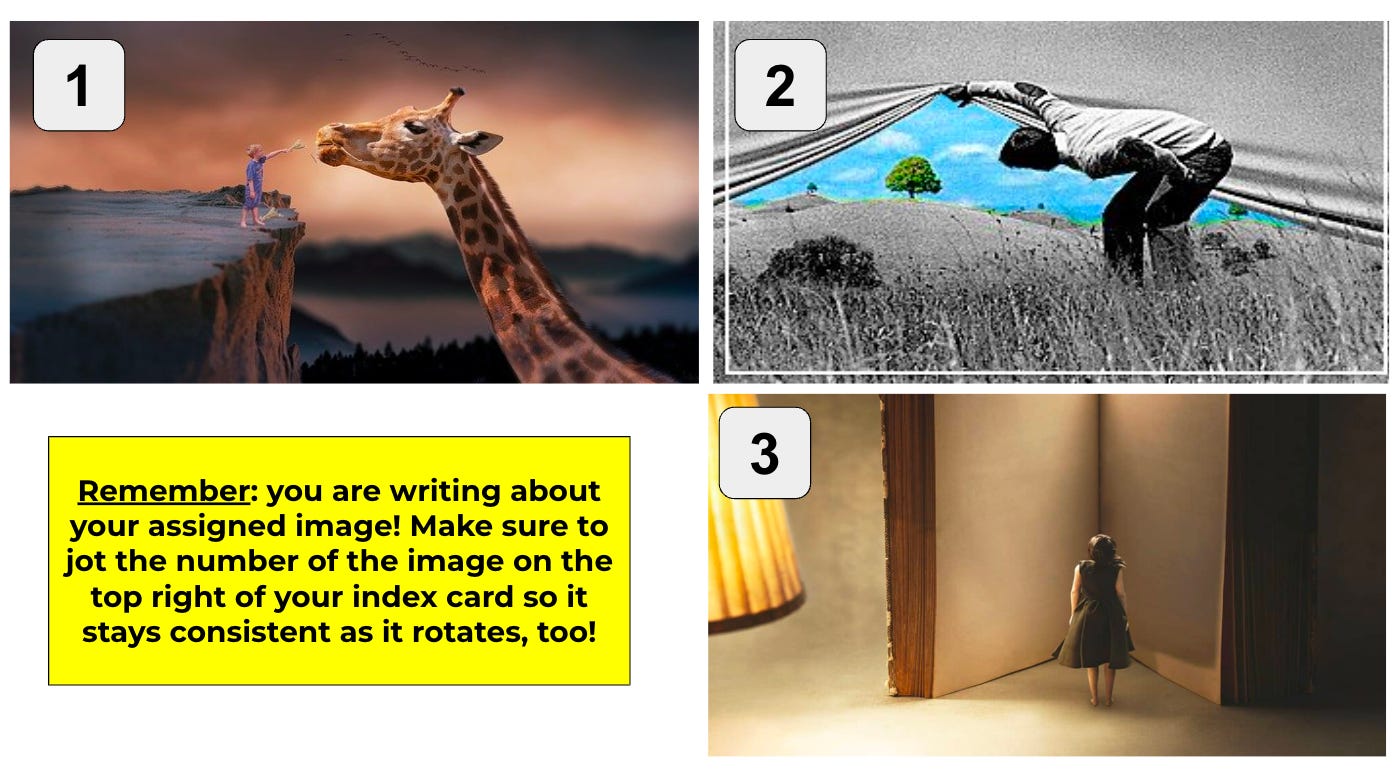What a 90-minute lesson can look like
a step-by-step example of how a lesson went in our classroom last week
I teach in a school district with a unique weekly bell schedule for its high schools:
Monday: all 8 class periods meet for a little over 40 minutes
Tuesday/Wednesday: modified A/B schedule, meaning Tuesday the first 4 periods meet for 75 minutes; Wednesday, the other 4 periods meet for 75 minutes. (This allows for Advisory, late start, etc.)
Thursday/Friday: full A/B schedule with 90-minute blocks for each class over the two days (Periods 1-4 Thursday, Periods 5-8 Friday)
Essentially, this means that I get to experience what it is like to teach 3 different class period lengths each week: ~40 minutes, then 75 minutes, then 90 minutes.
After several years of doing this weekly schedule shapeshifting, I feel like I can state unequivocally that regularly designing and facilitating a high-engagement, purposeful lesson for ninety minutes is without question one of the most challenging things I regularly do as a teacher.
Amidst worthwhile conversations around dissipating engagement levels the longer students are in the K-12 school system, the increasingly-transactional culture of education, and the potential pitfalls of excessive screen time for students with 1:1 devices, though, I think what can get lost are the nuts and bolts of what these lessons actually look like.
So for this weekend’s post, I wanted to offer a tour of sorts of a recent ninety-minute lesson in our classroom—one with zero use of 1:1 technology for students and very high engagement.
Does it take a lot as a teacher to make a lesson like this happen? Yes, and one of my intentions here is to offer a clearer picture of what that “a lot” entails.
Is it worth it that work when the classroom is humming with a clear direction and purpose? Yes.
Here we go, then: a ninety-minute lesson that we ended the week with recently introducing the concept of a Shakespearean sonnet to 30+ student class of high school juniors.
Part ⓵: Skill-Aligned Note Taking
Wait, wasn’t this supposed to be a high engagement lesson?
I mean, there is a GIF on the slide.
More seriously, though, I think sometimes we get locked into a fixed idea of what the shape of lesson needs to look like and consequently find ourselves trapped in the false dichotomy between engaging aspects of the lesson and those that are purposeful towards the learning in the classroom.
In this lesson, students needed to have some clearly-defined knowledge around sonnet structure for the subsequent activities—knowledge they would need to reference throughout the lesson as a means of reinforcing it.
Did that mean starting with a few slides of notes after our typical essential question and spiral set-up routine? Yep, and it was perfectly fine and important.
Estimated Time (including lesson opening/set-up): 20 minutes
Part ⓶: Challenge Time ➡ Sonnet Reconstruction
Nothing like a good curveball ten minutes in to shake up the lesson!
Our focus poem for the lesson was William Shakespeare’s “Sonnet 34”—but before we got to our usual reading and annotating, I wanted to inject a little hands-on learning into the classroom with a fun competition.
Before the lesson started, I had cut out copies of “Sonnet 34” into individual lines (without line numbers) and paper-clipped them together in random order.
The challenge? Groups had to use their notes on the structure and rhyme scheme of Shakespearean sonnets to reconstruct the poem in correct order.
Did I blast music from Survivor and intermittently name the progress of groups randomly a la Jeff Probst throughout? You betcha. I even designed clues to help push groups in the right direction (ex: “The fourth line makes me think of the idea of courage!” and “This particular sonnet happens to end with a slant rhyme!”) while the stakes increased, as each group had one chance to submit correctly before being…eliminated!
(Did I take pleasure in reading through incorrect submissions as if they were correct only to shout “THIS GROUP HAS BEEN ELIMINATED!” to the entire classroom? You betcha.)
The entire time we were doing this, students were 100% locked in and competitive while laughing at each other, too, fully aware that that this was another case of “Mr. Luther doing too much”—which was precisely the point, especially since every group was constantly referring to the notes they had just taken in order to “unlock” the correct answer.
As I said said, the engagement v. rigor conversation? Very much a false dichotomy.
Estimated Time: 15 minutes
Part ⓷: Close-Reading and Discussion of the Poem
At this point, we’ve reached the heart of the lesson: our whole-class reading and interpretation of the poem. Students had the tools they need for this work via their notes and now through the competition had already begun to understand its structure—and more importantly, in my opinion, we were building momentum in terms of classroom energy.
Without digressing into how much I love teaching poetry in terms of its magical ability to build authentic, curious discussion in the classroom, we essentially then moved through this sequence with the poem:
I read the first four lines aloud, and then students quickly highlighted and annotated one word or phrase that stood out to them.
Group discussion commenced as they shared their annotations with their shoulder partners and worked to arrive at a paraphrase of those lines—and then we debriefed whole-class.
Rinse-repeat for the next four lines, and the next four, and then the final couplet.
(Oh, and this particular poem? After building towards the speaker’s animosity towards the “sun”—or, symbolically, a person with trust and/or power that they misplaced their trust in before being betrayed—for the first twelve lines, the final heroic couplet resolves all of their animosity in a very frustrating way to encounter…which then gets to the slant rhyme and Shakespeare’s potential winking at us of this very-real dynamic of the victim feeling obligated to forgive before they’re ready. Poetry’s cool, right!?!)
Estimated Time: 20 minutes
Part ⓸: Independent Practice + Peer Debrief
For the traditionalists out there, I’m happy to refer to this as the “independent practice” segment of the lesson—students taking what they gleaned from collaborative work and whole-class discussion and then applying it with specific analyses in their spiral notebook. The quiet thinking and writing space was needed at that point in the lesson, too, especially given the energy of the room up until that point.
That said, I don’t believe for a second that “independent practice” needs to conclude independently.
Instead, students ended this portion of lesson by standing up and exchanging answers with each other, seeing how classmates navigated the same application activity and, as a result, reflecting on their own choices.
Estimated Time: 15 minutes
Part ⓹: Closing “Group Quatrain Challenge”
Especially as this group of students were kinda-sorta feeling themselves after admittedly showing out with their latest narrative poem projects, I felt like the one ingredient missing was an activity in empathy and humility: a chance for students to see for themselves how challenging it is to construct their own rhyming quatrain that abides by the rules of a Shakespearean sonnet.
To make it a bit more challenging, though, and a lot more fun?
Students were assigned “story-starter images” to base their four-line poems off, ranging from a child feeding a gigantic giraffe atop a cliff to a mysterious person in the foreground lifting a black-and-white curtain to reveal a world of color behind it. (see above)
Students had to rotate their poems after each line in their group: so Student A would write Line 1 for the first poem and then pass it to a group member who would write Line 2, etc., until the poem ended up back at the original author who had a chance to decide upon the title.
Oh, and they only had two minutes to write each line.
Immediately I watched groups revive themselves with energy as they were snapping and clapping their syllable counts and trying not to create dead-ends for their group members with required end-rhymes. Laughter, too. Lots of it. (Especially when one student had to leave and therefore “Mr. Luther had to sub in” to complete the activity that class period!)
Each group selected their best “index card poem” and submitted it at the end of the period, which I judged and declared winners on to “sign the crown” the following lesson—and then the bell finally rang. Lesson over.
Estimated Time 20 minutes
A Brief Debrief with a Dose of Why
To recap the five parts of the lesson (full slide deck here):
Note-taking with required skills
Hands-on activity/competition
Collaborative and whole-class discussion
Independent practice and peer debrief
Culminating application challenge
Did students walk out of this lesson absolutely drained? Without question, with several “Mr. Luther was doing too much again” mutterings (and sometimes louder than mutterings!) but almost always with smiles upon their faces.
Of course, not every lesson is like this, as this same group of students just recently had a 90-minute in-class essay that very much did not have any hands-on activities aside from their furious typing away at their essays.
But my goal here today is three-fold:
To transparently walk you through what I consider “the bar” of what I try to aim for in designing and facilitating student learning experiences
To intentionally name and show how much goes into the designing and preparing of a lesson like this (and yes, experience helps a lot!)
To confidently claim that this is what classrooms can aspire towards: engagement walking hand-in-hand with purpose, and students laughing right alongside their learning
Again, this is not a bar I always hit in my own classroom, yet at the end of the day I’d rather set a higher standard and then every once in a while end up there.
Because on days like this one? There’s no better place than the classroom.











This is awesome. Lesson examples like this, at this level of planning and engagement, would make a great book.
LOVE this! I may be stealing the sonnet competition--what fun!